
Urtica dioica, often known as common nettle, burn nettle, stinging nettle or nettle leaf, or just a nettle or stinger, is a herbaceous perennial flowering plant in the family Urticaceae. Originally native to Europe, much of temperate Asia and western North Africa, it is now found worldwide. The species is divided into six subspecies, five of which have many hollow stinging hairs called trichomes on the leaves and stems, which act like hypodermic needles, injecting histamine and other chemicals that produce a stinging sensation upon contact.

Tragia is a genus of flowering plants in the spurge family, Euphorbiaceae. It is widespread across North and South America, Africa, the Arabian Peninsula, the Indian Subcontinent, northern Australia, and to various islands in the Caribbean and in the Indian Ocean.

Stenocereus thurberi, the organ pipe cactus, is a species of cactus native to Mexico and the United States. The species is found in rocky desert. Two subspecies are recognized based on their distribution and height. The Organ Pipe Cactus National Monument is named for the species. Cacti are minimally adapted to particular thermal niches, and are tremendously vulnerable to seasonal precipitation.
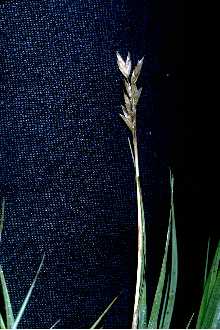
Distichlis spicata is a species of grass known by several common names, including seashore saltgrass, inland saltgrass, and desert saltgrass. This grass is native to the Americas, where it is widespread. It can be found on other continents as well, where it is naturalized. It is extremely salt tolerant.
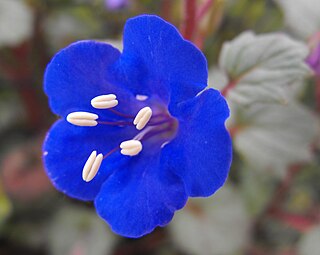
Phacelia campanularia is a species of flowering plant in the borage family, Boraginaceae, known by the common names desertbells, desert bluebells, California-bluebell, desert scorpionweed, and desert Canterbury bells. Its true native range is within the borders of California, in the Mojave and Sonoran Deserts, but it is commonly cultivated as an ornamental plant and it can be found growing elsewhere as an introduced species.

Cochemiea dioica, also called the strawberry cactus, California fishhook cactus, strawberry pincushion or fishhook cactus, is a cactus species of the genus Cochemiea. Its common name in Spanish is biznaga llavina. Temperature along with precipitation are consequential factors in distributing plant species.

Lonicera sempervirens is a flowering plant species of honeysuckle vine native to the eastern United States which is known for its reddish flowers.
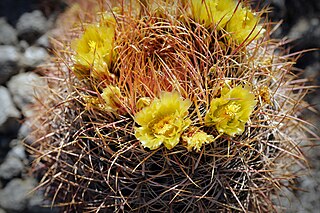
Ferocactus cylindraceus is a species of barrel cactus which is known by several common names, including California barrel cactus, Desert barrel cactus, compass barrel cactus, and miner's compass. It was first described by George Engelmann in 1853.
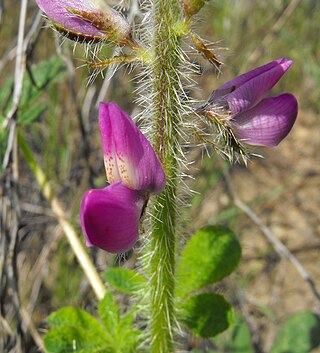
Lupinus hirsutissimus is a species of lupine known by the common names stinging annual lupine or stinging lupine. It is native to the coastal mountains of Baja California and Southern California as far north as the San Francisco Bay Area. It grows on dry mountain slopes, including areas that have recently burned, and chaparral and woodlands habitats.

Orobanche ramosa is a species of broomrape known by the common names hemp broomrape and branched broomrape. It is native to Eurasia and North Africa, but it is known in many other places as an introduced species and sometimes a noxious weed.

Stellaria longipes is a species of flowering plant in the family Caryophyllaceae known by the common names longstalk starwort and Goldie's starwort. It has a circumpolar distribution, occurring throughout the northernmost latitudes of the Northern Hemisphere. It is a perennial herb that grows in a wide variety of habitat types, including tundra and taiga and many areas farther south with subalpine and alpine climates. It is extremely variable in morphology, its form depending on both genetic makeup and environmental conditions. It has a widely varying number of chromosomes. In general, it is a rhizomatous perennial herb forming mats or clumps, or growing erect. The stems may be short and simple or with sprawling and highly branched. The linear to lance-shaped leaves are usually 1 to 4 centimeters long and are oppositely arranged in pairs. The inflorescence bears one or more flowers, each on a short pedicel. The flower has five pointed green sepals each a few millimeters long. There are five white petals each divided into two lobes, sometimes shallowly, but often so deeply there appear to be two petals. The plant is gynodioecious, with some flowers having functional male and female reproductive parts and others being only female.

Tetracoccus hallii is a species of flowering shrub in the family Picrodendraceae, known by the common names Hall's shrubby-spurge and Hall's tetracoccus.
Tetracoccus ilicifolius is a rare species of flowering shrub in the family Picrodendraceae known by the common names hollybush and holly-leaved tetracoccus.
Prunus eremophila, also known by its common name Mojave Desert plum, is a rare species of plum native to California.

Tragia durbanensis, the stinging nettle creeper, is a twining herb in the family Euphorbiaceae, with a restricted distribution in southern Africa. There are some 150 species in the genus Tragia.
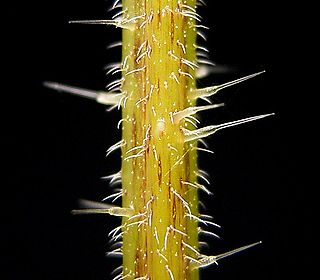
A stinging plant or a plant with stinging hairs is a plant with hairs (trichomes) on its leaves or stems that are capable of injecting substances that cause pain or irritation.

Urtica gracilis, commonly known as the slender nettle, tall nettle, or American stinging nettle, is a perennial plant plant without woody stems that is well known for the unpleasant stinging hairs on its leaves and stems. It is native to much of the North America from Guatemala northwards and temperate areas of South America. It is easily confused with the visually very similar Eurasian species Urtica dioica and is still listed in some resources as a subspecies of this plant. However, genetic analysis and experiments show that they are genetically distinct.

Tragia urticifolia, commonly called nettleleaf noseburn, is a species of flowering plant in the spurge family (Euphorbiaceae). It is native eastern to North America, where it is found in the southeastern United States. Its typical natural habitat is in rocky or sandy dry woodlands, over calcareous or mafic substrates.
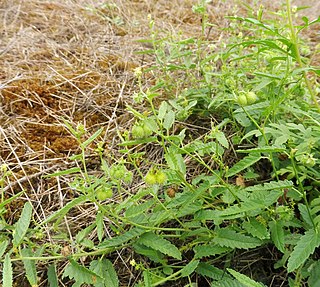
Tragia betonicifolia, commonly called betonyleaf noseburn, is a species of flowering plant in the spurge family (Euphorbiaceae). It is native to North America, where it is primarily found in the South-Central region of the United States extending north into Kansas and Missouri, with disjunct populations east in Tennessee. Its typical natural habitat is dry areas with sandy or rocky soil, in glades, prairies, bluffs, and dry woodlands.

Polygala ramosa is a species of flowering plant in the milkwort family (Polygalaceae). It is endemic to the coastal areas of the Southern and Eastern United States. It is an annual herb with a height of 10 to 40 centimetres that produces yellow flowers between the months of May and September.



















